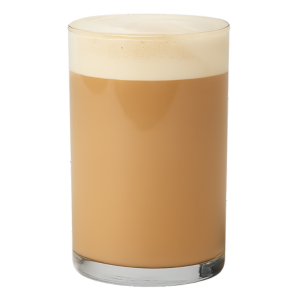
Spanish Latte
Caffeine
130–150 mg
Note: Caffeine amounts are based on a standard Spanish Latte recipe using two shots of espresso in a 12 fl oz serving. Actual caffeine may vary depending on the café, espresso roast, and number of shots used. Iced versions contain the same caffeine but may taste lighter due to dilution.
| Attribute | Value |
|---|---|
| Caffeine Level | Moderate to High |
| Serving Size | 12 fl oz |
| Serving Size (ml) | 355 ml |
| Caffeine | 130–150 mg |
| Calories | 200–250 kcal |
| Sugar | 25–30 g |
| Caffeine per fl oz | 11–12 mg/fl oz |
The Spanish Latte, also known as Café con Leche in Spain, is a creamy, sweetened coffee drink made with espresso, steamed milk, and sweetened condensed milk. Its richer texture and added sweetness set it apart from a standard latte, making it a favorite in specialty cafés worldwide.
What Is a Spanish Latte and How Is It Different from a Regular Latte?
A Spanish Latte is similar to a traditional latte but with a sweeter, creamier twist. The addition of condensed milk changes both the flavor and nutritional profile.
- Espresso Base – Typically made with 1–2 shots of espresso.
- Steamed Milk – Provides creaminess and balances the espresso.
- Sweetened Condensed Milk – Adds sweetness and richness.
- Optional Spices – Cinnamon or cocoa powder for extra flavor.
Compared to a regular latte, the Spanish Latte is sweeter, creamier, and slightly higher in calories, while the caffeine content depends on the espresso shots used.
Key Ingredients That Influence Caffeine in a Spanish Latte
The caffeine level in a Spanish Latte depends on the type and amount of coffee used.
- Espresso Shots – Each shot contains 63–75 mg of caffeine.
- Roast Type – Dark roasts taste stronger but may have slightly less caffeine than light roasts.
- Milk Ratio – More milk dilutes caffeine concentration but doesn’t reduce total caffeine.
- Condensed Milk – Adds sweetness but no caffeine.
Ultimately, the espresso shots are the sole caffeine source, making them the key factor in determining strength.
Caffeine Content by Size (Small, Medium, Large)
Spanish Lattes are usually served in café-style sizes, with caffeine scaling by espresso shots.
- Small (8 oz, 1 shot) – 65–75 mg caffeine
- Medium (12 oz, 2 shots) – 130–150 mg caffeine
- Large (16 oz, 3 shots) – 195–225 mg caffeine
This places the Spanish Latte in the moderate-to-high caffeine range, similar to a regular latte or cappuccino.
Hot vs. Iced Spanish Latte: Does Caffeine Change?
The caffeine content in a Spanish Latte doesn’t change much between hot and iced versions, but the experience does.
- Hot Spanish Latte – Served with steamed milk and foam, same caffeine per shot.
- Iced Spanish Latte – Espresso poured over cold milk and ice, same caffeine but more diluted flavor.
- Cold Brew Variation – If made with cold brew instead of espresso, caffeine may be higher (~150–200 mg per 12 oz).
So while the caffeine remains consistent, the perception of strength can differ based on temperature and dilution.
Spanish Latte vs. Regular Latte: Caffeine Comparison
Both drinks use espresso as the caffeine source, but their recipes differ slightly.
- Spanish Latte (12 oz) – 130–150 mg caffeine, sweeter and creamier.
- Regular Latte (12 oz) – 130 mg caffeine, less sweet, more milk-forward.
- Flat White (12 oz) – 130–150 mg caffeine, stronger coffee flavor due to less milk.
In terms of caffeine, the Spanish Latte is nearly identical to a regular latte, but the condensed milk makes it taste richer and more indulgent.
Recipe Variations and How They Affect Caffeine Levels
Different recipes and customizations can change the caffeine profile of a Spanish Latte.
- Extra Shot – Adds 65–75 mg caffeine.
- Blonde Espresso – Slightly higher caffeine than standard espresso.
- Decaf Espresso – 3–15 mg caffeine per shot, for a low-caffeine option.
- Cold Brew Base – Higher caffeine, 150–200 mg per 12 oz.
- Alternative Milks – Almond, oat, or soy milk don’t affect caffeine.
These variations allow you to tailor the drink to your caffeine tolerance and taste preferences.
